livestock feed mixers
Dec . 09, 2024 15:49 Back to list
livestock feed mixers
The Importance of Livestock Feed Mixers in Modern Agriculture
In the rapidly evolving world of agriculture, effective livestock management plays a crucial role in ensuring food security and sustainable farming practices. Among the various tools and technologies that contribute to this goal, livestock feed mixers stand out for their significance in enhancing feed efficiency and promoting animal health. This article explores the advantages of feed mixers, the different types available, and their impact on livestock farming.
Understanding Feed Mixers
Livestock feed mixers are machines designed to blend various types of feed ingredients into a homogenous mixture. This process is essential, as animals require a balanced diet to thrive, and feed ingredients often vary in nutritional content. By utilizing a feed mixer, farmers can create customized feed rations that meet the specific dietary needs of their livestock, whether it be cattle, pigs, poultry, or other farm animals.
Feed mixers can handle different types of ingredients, including grains, forages, minerals, and supplements. The mixing process ensures that each animal receives an even distribution of nutrients, which is critical for growth, reproduction, and overall health. Inadequate or imbalanced feeding can lead to poor performance, increased susceptibility to diseases, and lower profitability for farmers.
Types of Livestock Feed Mixers
There are several types of livestock feed mixers available on the market, each serving distinct needs and preferences
1. Vertical Mixers These mixers utilize a vertical auger to lift feed ingredients vertically and then mix them thoroughly. Vertical mixers are particularly effective for mixing large volumes of dense feed materials and are often preferred for their efficiency and minimal feed wastage.
2. Horizontal Mixers As the name suggests, horizontal mixers have a horizontal mixing chamber and are equipped with augers that move feed ingredients laterally. These mixers are versatile and can handle a variety of feed types, making them suitable for farms with diverse livestock.
livestock feed mixers

3. Twin-Screw Mixers Featuring two counter-rotating augers, twin-screw mixers are known for their rapid mixing capabilities and ability to facilitate precise ingredient distribution. They are ideal for creating high-quality feed blends quickly.
4. Batch Mixers Designed for smaller operations, batch mixers allow farmers to create feed mixtures in smaller quantities, ensuring freshness and reducing waste. These mixers are typically simpler and more affordable options for family-run farms or smaller livestock operations.
Benefits of Using Feed Mixers
Adopting a livestock feed mixer can greatly enhance farming operations. One of the primary benefits is improved feed efficiency. Well-mixed feed ensures that livestock consume a balanced diet, leading to better weight gain, improved milk production, and increased reproductive success.
Another significant advantage is time and labor savings. Manual mixing is not only labor-intensive but also time-consuming. Feed mixers streamline the process, allowing farmers to dedicate their time and resources to other vital farm tasks.
Moreover, feed mixers contribute to consistency in feed quality. By standardizing rations, farmers can lessen the chances of feed-related health issues and variability in animal performance. This consistency helps maintain optimal growth rates and reduces the risk of costly veterinary expenses.
Conclusion
In conclusion, livestock feed mixers are indispensable tools in modern agriculture, significantly contributing to the efficiency, productivity, and sustainability of livestock operations. By enabling farmers to create well-balanced, customized feed rations, these mixers support the health and performance of farm animals, ultimately helping to meet the growing demand for livestock products. As the agricultural landscape continues to evolve, the integration of technology like feed mixers will play an essential role in shaping the future of livestock management and food production.
-
Hot Sale 24 & 18 Door Rabbit Cages - Premium Breeding Solutions
NewsJul.25,2025
-
Automatic Feeding Line System Pan Feeder Nipple Drinker - Anping County Yize Metal Products Co., Ltd.
NewsJul.21,2025
-
Automatic Feeding Line System Pan Feeder Nipple Drinker - Anping County Yize Metal Products Co., Ltd.
NewsJul.21,2025
-
Automatic Feeding Line System - Anping Yize | Precision & Nipple
NewsJul.21,2025
-
Automatic Feeding Line System - Anping Yize | Precision & Nipple
NewsJul.21,2025
-
Automatic Feeding Line System-Anping County Yize Metal Products Co., Ltd.|Efficient Feed Distribution&Customized Animal Farming Solutions
NewsJul.21,2025






